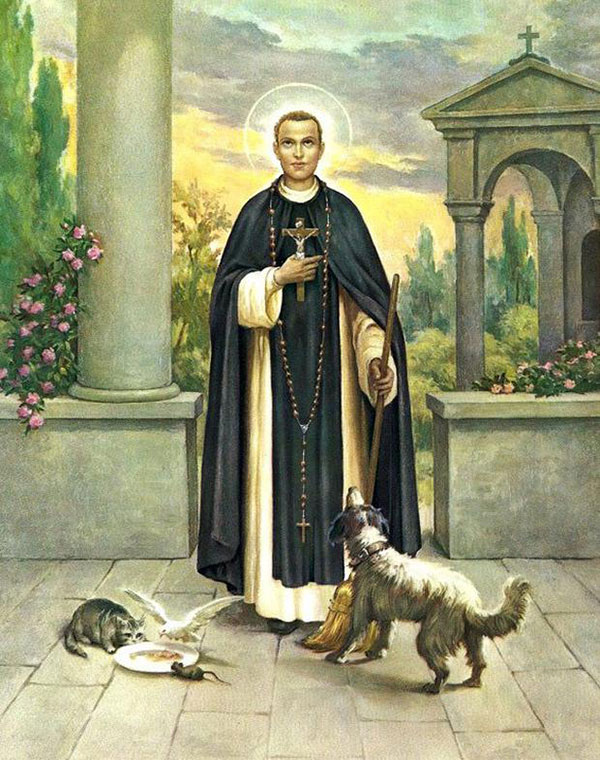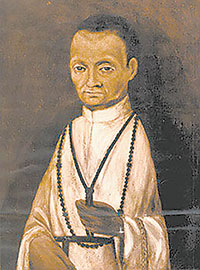First black saint of the Americas
 On Nov. 3 the Church celebrated the feast day of St. Martin de Porres, a Peruvian Dominican brother whose life of charity and devotion led to his canonization as the first black saint of the Americas.
On Nov. 3 the Church celebrated the feast day of St. Martin de Porres, a Peruvian Dominican brother whose life of charity and devotion led to his canonization as the first black saint of the Americas.
Martin de Porres was born in Lima, Peru, in 1579, the son of the Spanish nobleman Don Juan de Porres and the former Panamanian slave Ana Velazquez. His father at first refused to acknowledge the boy publicly as his own because Martin, like his mother, was black. Though Martin’s father later helped to provide for his education, his son faced difficulties because of his family background.
But Don Juan’s son showed great gifts at a young age. Martin served as apprentice to a doctor, and before the age of 13 he had begun to learn the practice of medicine. The young man also spent hours in prayer and practiced forms of physical mortification for the good of his soul and others.
During these years Martin had also become a member of the Dominican Third Order, which promoted the group’s spiritual practices among laypersons. He lived in their quarters and did manual work to earn room and board. But a law preventing people of mixed race from joining religious orders kept him from entering the
Dominican order as a religious brother until 1603.
Before his full admission to the order, Martin had earned the nickname of “the saint of the broom” for his diligence in cleaning the Dominicans’ quarters. After becoming a religious brother, he worked in the order’s infirmary serving the sick, a job he performed until his death.
He also had the task of begging for alms that the community would use to feed and clothe the poor. Meanwhile, he established an orphanage, as well as an orchard from which those in need could freely take a day’s supply of fruit.
Victims of medical misfortune began to suspect miracles behind some of the deeply prayerful physician’s cures. Others claimed he had appeared to them supernaturally behind locked doors or under otherwise impossible circumstances. Martin reportedly also had the gift of bilocation, and some of his contemporaries said they encountered him in places as far off as Japan even as he remained in Lima.
Others, meanwhile, marveled at his serenity and generosity.
“Many were the offices to which the servant of God, Brother Martin de Porres, attended,” testified Brother Fernando de Aragones. “Each of these jobs was enough for any one man, but alone he filled them all with great liberality, promptness and carefulness, without being weighed down by any of them.”
“It was most striking, and it made me realize that, in that he clung to God in his soul, all these things were effects of divine grace.”
Martin also loved animals. The saint refused to eat meat, and he ran a veterinary hospital for the sick creatures that seemed to seek out his help and protection.
Portrayals of the saint often include cats, dogs and even the rats to whom he showed compassion.
Many residents of Lima already spoke of Brother Martin de Porres as a living saint before his death at age 60 on Nov. 3, 1639. But his canonization did not occur until 1962, under Pope (later St.) John XXIII. He is known as a patron of interracial harmony and care for the poor.
— Catholic News Agency
St. Martin de Porres, ‘saint of the broom’
 St. Martin de Porres was born in Lima, Peru, on Dec. 9, 1579 as the son of Spaniard Juan de Porres and a freed black slave from Panama, Ana Velasquez. Being of mixed race, Martin was of a lower social caste, though his father looked out for him and made sure the boy was apprenticed in a good trade.
St. Martin de Porres was born in Lima, Peru, on Dec. 9, 1579 as the son of Spaniard Juan de Porres and a freed black slave from Panama, Ana Velasquez. Being of mixed race, Martin was of a lower social caste, though his father looked out for him and made sure the boy was apprenticed in a good trade.
Martin studied to be a barber, which, at that time, meant that he also learned medicine. He became very well known for his compassion and skill as a barber, and cared for many people as well as animals.
Under Peruvian law, descendants of Africans and Native Americans were barred from becoming full members of religious orders. The only route open to the faith-filled boy was to ask the Dominicans of Holy Rosary Priory in Lima to accept him as a “donado,” a volunteer who performed menial tasks in the monastery in return for the privilege of wearing the habit and living with the religious community. At the age of 15 he asked for admission to the monastery and was received first as a servant boy, and as his duties grew he was promoted to almoner. He later took on kitchen work, laundry and cleaning. After eight years, the prior of the monastery decided to ignore the law and permitted Martin to take vows as a Third Order Dominican, which meant he was a lay man associated with the order, living at the monastery. Not everyone at the monastery accepted Martin, however, and he was verbally abused as a “mulatto dog” and mocked.
When Martin was 24, he was allowed to profess religious vows as a Dominican lay brother. He is said to have several times refused this elevation in status, which may have come about due to his father’s intervention, and he never became a priest. It is said that when his monastery was in debt, he implored them: “I am only a poor mulatto, sell me.”
Martin’s prayer life was intense, and he practiced many mortifications. He was known to levitate in ecstasy in front of the altar, but he also subjected himself to many severe penances. He was considered to be very wise, and many people sought out his advice and intercession.
He was noted for his work on behalf of the poor, establishing an orphanage and a children’s hospital. He maintained an austere lifestyle, which included fasting and abstaining from meat. Among the many miracles attributed to him besides levitation were bilocation, miraculous knowledge, instantaneous cures and an ability to communicate with animals.
He ministered without distinction to Spanish nobles and to slaves brought from Africa, curing the sick and often bringing in the sick to his own bed in the monastery when there was no room in the infirmary. One day he found a poor Indian on the street, bleeding to death from a dagger wound, and took him to his room. When he heard of this, the prior reprimanded him. Martin replied, “Forgive my error, and please instruct me, for I did not know that the precept of obedience took precedence over that of charity.” The prior gave him liberty thereafter to follow his inspirations in the exercise of mercy.
He died aged 59 on Nov. 3, 1639, and though an investigation of his life proceeded rapidly after his death, his candidacy for canonization was delayed for more than 300 years due to a series of delays, natural disasters and shipwrecks. He was finally canonized in 1962 by Pope John XXIII.
He is the patron saint of mixed-race people, barbers, innkeepers, public health workers, and all those seeking racial harmony.
— Catholic News Agency
More online
Read about more black Catholics throughout history in our special feature commemorating Black Catholic History Month in November.


